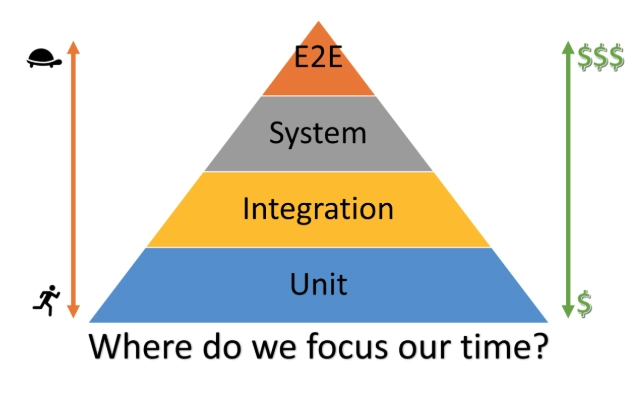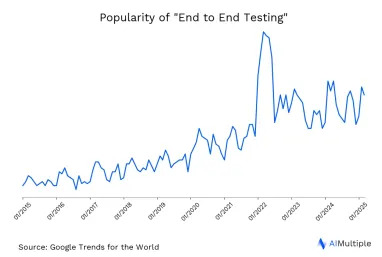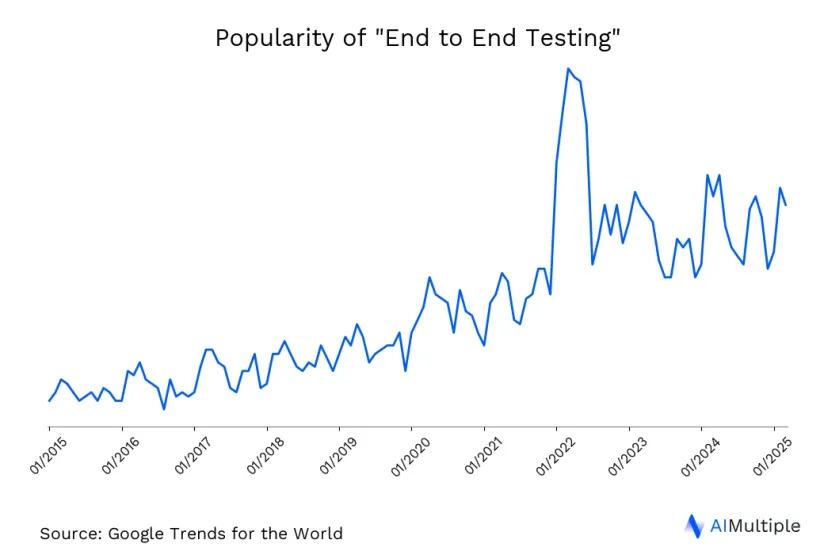The end user determines the success of the apps, websites, and services that businesses offer. If the end product does not constantly fulfill the changing needs and expectations of the user, no matter how big the developer is, it will fall short. End-to-end (E2E) testing helps businesses and QA teams to get a realistic perspective from the user’s eyes.
With well-designed E2E testing, companies can better understand how quick, reliable, and entertaining an application is for their users. We provide the best practices for E2E testing so that developers and business leaders can ensure their practices are up-to-date.
What is end-to-end testing?
End-to-end testing is a method of testing a complete application environment in a situation that mimics real-world use, it includes:
- Interacting with a database
- Using network communications
- Interacting with other hardware, applications, or systems if appropriate.
End-to-end testing identifies system dependencies and maintains data integrity between various system components and systems. It is a method that validates an application’s workflow from start to finish, which can be a slow and costly process (see figure 1), but an essential one nevertheless.
Figure 1: Testing Practices

Source: Microsoft.1
Why is end-to-end testing important?
End-to-end testing is essential because it helps QA teams identify system dependencies and ensure that the overall flow of the application is working as expected. It tests the application as a whole, simulating real-world scenarios and user interactions. Consequently, it can help to uncover issues that may not be detected during unit tests or integration tests. See system testing vs end-to-end testing to understand the differences between software testing practices better.
End-to-end testing can also ensure that data integrity is maintained between different system components and systems, which is crucial for applications to function properly.
Furthermore, E2E testing can help identify performance bottlenecks and scalability issues. It is a valuable practice for ensuring that an application is functioning correctly and ready for release. It can help QA teams understand the software and hardware requirements to enhance the user experience.
How to perform end-to-end testing?
- Analyze Requirements: Gain a clear understanding of the application’s core functionality and the flow of user interactions.
- Plan Testing: Define the testing scope, key objectives, and timeline for the testing process.
- Set Up Test Environment: Configure a testing environment that closely replicates the production environment.
- Design Test Cases: Develop comprehensive test cases that account for all possible user scenarios.
- Execute Tests: Carry out the test cases, either through manual testing or using automation tools.
- Analyze Results: Review test outcomes to identify defects or areas that need improvement.
- Report Findings: Document the results and share insights with the development team for corrective action.
7 End-to-end testing best practices
1. Test the entire user journey
While it may be beneficial to first focus on the most popular workflow of your application, testing the entire components of an application is critical.
For example, Airbnb’s most popular workflow could be its search engine. However, the users won’t even use the search engine if the overall UI is not seamless. That is why you should ensure that all parts of the application, including the UI, API, and database, are tested together to ensure that everything works as expected.
Low-code test automation tools may prove useful for those who lack technical expertise.
2. Use concrete and realistic data
Using real data sets while testing the application is essential to ensure that the application behaves correctly in a production environment. Test cases and test execution is essential; however, they would not serve their purpose without proper test data. That’s why you should avoid using production data frequently and refer to test data management (TDM).
When people use websites and apps, they observe various components. For example, when a person reads an article, he/she can stop and look at the citation for a source or description of an image. It is unlikely that a user will skim through a website with no attention to detail. Therefore, end-to-end testing should simulate real-world interaction.
3. Test the edge cases
Ensure that the application is tested in all possible scenarios, including error conditions and edge cases. Edge cases in software testing refer to test scenarios that fall outside the most commonly expected inputs or usage of a system or software.
Examples of edge cases for end-to-end tests might include:
- Testing a system with extremely large or small inputs
- A system with unexpected combinations of inputs
- Testing a system with inputs outside its intended range of use.
4. Test with different environments
You should test the application in different environments, such as different browsers, operating systems, and devices, to ensure that it works correctly in all of them.
For example, a website may look good and work well in Google Chrome, but the same website can have issues in Safari, Firefox, or Opera. It is essential to consider different environments since various users utilize different types of services.
5. Automate the tests
Software development practices are developing rapidly. Organizations need to offer high-quality software swiftly and consistently if they want to remain competitive. That is why automating testing process will save time and reduce the chances of human error; this is also the case for end-to-end testing. Test automation tools can help with these.
Software programs are prone to regressions. By preparing test suites and thoroughly retesting the entire program after every change, you can guarantee that the code you’re releasing is of the highest quality. That is why automating end-to-end tests will increase the quality of your end product.
6. Document the test cases
Keep records of all test cases and their results to ensure that all application parts have been tested. Test documentation automation will be helpful to provide a reference for future testing.
For this practice, test automation tools can help you document test cases better. Each test case can help you better understand your product; for end-to-end tests, you will also have the chance to reflect upon the user experience.
7. Test continuously
Continuous testing is an important practice for end-to-end testing. End-to-end testing should be an ongoing process, conducted as part of the development process and as part of ongoing maintenance and updates. Implementing continuous testing to prevent data errors provides 55% better and three times faster corrections.
What are the types of end to end testing?
1. Horizontal End-to-End Testing
This type of testing focuses on the entire user journey across different systems, interfaces, and functionalities, simulating real-world scenarios from a user’s perspective. The goal is to ensure that the system behaves as expected when used as a whole.
Example: In an e-commerce platform, horizontal testing would simulate a customer searching for a product, adding it to the cart, making a payment, and receiving an order confirmation. The test covers the user interface (UI), application programming interface (API), and database interactions.
2. Vertical End-to-End Testing
Vertical testing drills deeper into individual layers of the application or system, focusing on internal components like backend services, databases, and middleware. It tests these components in sequence to ensure they work well together and that each layer performs its task correctly.
Example: In a banking application, vertical testing might validate that a payment transaction is accurately processed in the database, with correct updates to account balances and transaction histories, while also verifying the system’s communication with third-party payment gateways.
Subtypes of E2E Testing
In both horizontal and vertical approaches, E2E testing can be carried out manually or using automation:
| Subtype | Description | Pros | Cons |
|---|---|---|---|
| Manual E2E Testing | A tester goes through the entire process step by step, mimicking real-world scenarios to validate system behavior. | High flexibility in detecting unexpected issues; Human intuition catches subtle UX problems | Time-consuming; Prone to human error; Hard to scale for large systems |
| Automated E2E Testing | Automation tools simulate user interactions across the system; useful for repetitive tasks or complex scenarios. | Fast and repeatable; Scalable; Ideal for regression testing and continuous integration (CI) | High setup cost; Maintenance overhead; Less effective at catching UI/UX issues |
What are the challenges of E2E testing?
Complexity in Test Design
E2E testing has a broad scope, involving multiple components like the frontend, backend, databases, and external services, making test design intricate. Mapping out all user scenarios and edge cases can be especially daunting for complex systems.
High Resource Requirements
E2E tests are slower than unit or integration tests and require a staging environment that mirrors production. They often depend on specialized tools and skills, demanding significant infrastructure and expertise.
Test Fragility
Minor changes in the application, such as UI updates or API modifications, can frequently cause failures. External dependencies, like third-party integrations, can often lead to false negatives, and differences between testing and production environments may cause unpredictable behavior.
Maintenance Challenges
Test scripts must be regularly updated to keep pace with application changes. Debugging test failures can be time-consuming because of the interconnected nature of components.
Scalability Issues
As applications grow, E2E test suites become larger and harder to manage. This increases test execution time and makes it challenging to ensure tests can run in parallel without interference.
False Positives and Negatives
Unstable tests may fail sporadically due to environmental factors or timing issues, eroding trust in the test suite. Redundant or poorly designed tests can also create confusion about the actual cause of issues.
Cost
The time and effort required to create, execute, and maintain E2E tests can slow down development cycles. Tooling costs, whether for commercial solutions or configuring open-source options, will add to the expense.
Trade-offs Between Coverage and Feasibility
Striking the right balance between comprehensive coverage and maintaining efficient test execution is difficult. Over-reliance on E2E testing for scenarios better suited to unit or integration tests can lead to inefficiencies.
External Links
- 1. “E2E Testing” Microsoft Code With Egineering Playbook December 24, 2022



Comments
Your email address will not be published. All fields are required.